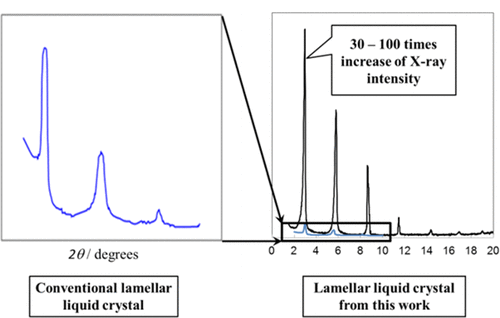当前位置:
X-MOL 学术
›
J. Am. Chem. Soc.
›
论文详情
Our official English website, www.x-mol.net, welcomes your
feedback! (Note: you will need to create a separate account there.)
Assembly of Lyotropic Liquid Crystals with Solid Crystal’s Structural Order Translated from the Lipid Rafts in Cell Membranes
Journal of the American Chemical Society ( IF 14.4 ) Pub Date : 2017-11-15 00:00:00 , DOI: 10.1021/jacs.7b06720 Yoon Seob Lee 1
Journal of the American Chemical Society ( IF 14.4 ) Pub Date : 2017-11-15 00:00:00 , DOI: 10.1021/jacs.7b06720 Yoon Seob Lee 1
Affiliation

|
Self-assembly offers a powerful way to control the complexity and hierarchy of nanoscale materials, and promises to create a diverse range of emergent properties. Successful syntheses that allow a delicate structural design of building units play an important role. However, as can be learned from many cellular processes and functions, coself-assembly using logically chosen additives should be equally effective in designing self-assembly. Herein I show that, translated from the dynamic nanoscale assemblies in cell membranes known as lipid rafts, coself-assembly of 1-decanol into cetyltrimethylammonium chloride micelles for the assembly of lyotropic liquid crystals generates new structural complexity and hierarchy, and a surprising property that is emerging from it. Designing the intermolecular forces in the way that cholesterol interacts with sphingolipids promotes the synergistic balance between the flexibility and rigidity, and the unique molecular recognition for silicic acid, followed by the micelle coalescence. This very much resembles the assembly process of the lipid rafts in cell membranes and triggers orders of magnitude of sharp increases in X-ray diffraction intensity. The analysis of the diffraction patterns shows that the structural order of these liquid crystals matches that of solid crystals, often of single crystals. Furthermore, the assembly of the liquid crystals promotes a substantial increase in the condensation rate of silicic acids by guiding them to form a silicate trimer along the surface of micelles. This very much resembles the role of the lipid rafts that sharply increases the reaction rate of biomolecules by guiding them to form discrete species along the surface of membranes. This finding demonstrates that it is possible to translate the key features of cellular processes and functions into artificial self-assembling systems of our choice using the building units that are readily available, thus creating novel soft materials.
中文翻译:

溶致液晶组装从细胞膜中的脂质筏转换成固态晶体的结构顺序。
自组装提供了一种控制纳米级材料的复杂性和层次结构的有力方法,并有望创建各种新兴特性。成功的合成技术可以使建筑单元进行精细的结构设计,发挥着重要作用。但是,从许多细胞过程和功能中可以了解到,使用逻辑选择的添加剂进行自组装在设计自组装方面应同样有效。在这里,我表明,从称为脂质筏的细胞膜中的动态纳米级组装转换而来,将1-癸醇自组装为十六烷基三甲基氯化铵胶束以用于溶致液晶的组装,会产生新的结构复杂性和层次结构,并且其令人惊讶的特性是从中脱颖而出。以胆固醇与鞘脂相互作用的方式设计分子间作用力,可以促进柔韧性和刚性以及硅酸独特的分子识别之间的协同平衡,然后形成胶束聚结。这非常类似于脂质筏在细胞膜中的组装过程,并引发X射线衍射强度急剧增加的数量级。衍射图的分析表明,这些液晶的结构顺序与固体晶体(通常是单晶)的结构顺序匹配。此外,液晶的组装通过引导它们沿着胶束的表面形成硅酸盐三聚体而促进了硅酸的缩合速率的显着提高。这非常类似于脂质筏的作用,通过引导生物分子沿膜表面形成离散的物种,从而大大提高了生物分子的反应速率。这一发现表明,可以使用容易获得的建筑单元将细胞过程和功能的关键特征转化为我们选择的人工自组装系统,从而创造出新颖的软质材料。
更新日期:2017-11-16
中文翻译:

溶致液晶组装从细胞膜中的脂质筏转换成固态晶体的结构顺序。
自组装提供了一种控制纳米级材料的复杂性和层次结构的有力方法,并有望创建各种新兴特性。成功的合成技术可以使建筑单元进行精细的结构设计,发挥着重要作用。但是,从许多细胞过程和功能中可以了解到,使用逻辑选择的添加剂进行自组装在设计自组装方面应同样有效。在这里,我表明,从称为脂质筏的细胞膜中的动态纳米级组装转换而来,将1-癸醇自组装为十六烷基三甲基氯化铵胶束以用于溶致液晶的组装,会产生新的结构复杂性和层次结构,并且其令人惊讶的特性是从中脱颖而出。以胆固醇与鞘脂相互作用的方式设计分子间作用力,可以促进柔韧性和刚性以及硅酸独特的分子识别之间的协同平衡,然后形成胶束聚结。这非常类似于脂质筏在细胞膜中的组装过程,并引发X射线衍射强度急剧增加的数量级。衍射图的分析表明,这些液晶的结构顺序与固体晶体(通常是单晶)的结构顺序匹配。此外,液晶的组装通过引导它们沿着胶束的表面形成硅酸盐三聚体而促进了硅酸的缩合速率的显着提高。这非常类似于脂质筏的作用,通过引导生物分子沿膜表面形成离散的物种,从而大大提高了生物分子的反应速率。这一发现表明,可以使用容易获得的建筑单元将细胞过程和功能的关键特征转化为我们选择的人工自组装系统,从而创造出新颖的软质材料。










































 京公网安备 11010802027423号
京公网安备 11010802027423号